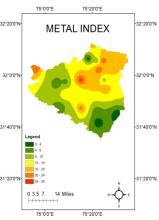Health Risk Assessment of Gurdaspur, Punjab, India Using Field Experiments and GIS: A Groundwater Perspective
| Abstract | Groundwater is a vital resource of potable water in India as almost all industries require water due to one or other reasons. It may get polluted by industrial waste, leachate from dumping yards, rampage, and uncontrolled use of pesticides. The physicochemical properties of water give a general indication of the interference capability of water with the normal biological process of the environment. Most heavy metals are present in trace amounts in the groundwater and useful for the human body. However, if they exceed the permissible limits these may cause health hazards. In this study, an attempt has been made to assess, analyze, and mapping groundwater quality using the Geographical information system (GIS). In this study, five heavy metals (aluminium, arsenic, cadmium, iron, selenium) and six physiochemical parameters (pH, total hardness, alkalinity, chloride, fluoride) have been used to achieve the objectives. Gurdaspur (Punjab, India) was selected for the study as it ranks fourth in the cancer cases after Amritsar, Ludhiana, and Bathinda as per the government reports. Field visits were made to collect samples and preservation techniques were followed according to standard methods (APHA 2005). Single-digit indices like the water quality index (WQI), heavy metal pollution index (HPI), metal index (MI) were used to classify the quality of water. Volumetric analysis and ion chromatography tests were carried out on the grab samples of 25 locations, which were collected in Dec’2019. Arsenic was found to exceed the permissible value in nearly 80% of samples. It has been observed that MI values exceeded the critical value of 1, indicating the pollution caused by the individual metal was more as compared to the pollution caused by all metals together. IDW interpolation technique was applied to all indices using GIS software to determine spatial distribution. Overall, WQI was found to be satisfactory, with only 20% of the sampling stations exceeding the acceptance value. The average value of the heavy metal pollution index (HPI) was 80% of the sampling stations. Further, an attempt has been made to determine the cancer risk of the inhabitants in the study area. The health risk index (HRI) was determined by chronic daily intake and hazard quotient as per USEPA. The hazard quotient (HQ) value of heavy metals was found to be greater than unity in all the selected areas, indicating that heavy metals pose a health threat in this region. It has been observed that the hazard quotient value is higher for children than adults, implying more vulnerability of children to a potential health hazard. Actual total cancer risk was found to be 33.65×10-4, which means ~34 persons in 10,000 people have the possibility of cancer. A hypothesis was that reduced the theoretical risk to 31.65×10-4 which was found to be comparable to the actual cancer risk. It has been observed that the cancer risk for children and adults were in the “high risk” category. The higher values of arsenic can be attributed to higher cancer risk and health quotient value. Both children and adults were found to be risk-prone to both carcinogen and noncarcinogen health effects, with children on the higher side. |
| Faculty |
Dr. Har Amrit Singh Sandhu
|
|
hassandhu@pec.edu.in
|
|
| More Information | DOI: https://doi.org/10.1007/s12594-022-2097-8 |







